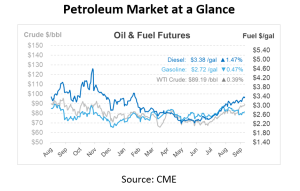
What Is It – Refining Capacity
As global demand for energy continues to grow, the need for all types of fuel will increase – both renewable and non-renewable. The refining industry stands at the crossroads of this energy demand, playing a vital role in converting raw crude into the fuels that power our world. But how do refineries gauge their capabilities? In today’s FUELSNews article, we explore the concept of refining capacity, its interplay with refinery utilization, and the broader implications for fuel prices and future energy strategies.
What is Refining Capacity?
Refining capacity refers to the maximum amount of crude oil that a refinery is designed to process over a given time frame, typically measured in barrels per day (BPD) or sometimes in metric tons per year. It represents the theoretical maximum output a refinery can achieve under optimal conditions, considering the facility’s design, equipment, and configuration. Essentially, it is the ceiling of how much crude oil the refinery can handle and transform into refined products.
Difference Between Refining Capacity and Refinery Utilization
In essence, while refining capacity provides a snapshot of a refinery’s potential, refinery utilization gives us a glimpse into its actual performance in real-world conditions. Refining capacity is inherently static and remains fixed in the short term. To change the refining capacity of a facility, one would need to undertake physical modifications or infrastructure upgrades. In contrast, refinery utilization is a dynamic metric. It fluctuates based on a myriad of factors, including market demand, crude oil supply, maintenance schedules, and unforeseen external disruptions, such as natural disasters.
Consider a scenario where a refinery boasts a refining capacity of 100,000 BPD. If this facility processes 90,000 BPD on a given day, its refinery utilization rate for that day stands at 90%.
The refining capacity serves as an indicator of a refinery’s size and its maximum potential output. Typically, facilities with larger refining capacities are expansive, equipped to cater to extensive markets or regions. On the other hand, the refinery utilization rate sheds light on the operational efficiency and real-time performance of the refinery. A high utilization rate can be a testament to a thriving demand or favorable operational conditions. Conversely, a dip in these rates might hint at ongoing maintenance activities, disruptions in supply, or a lull in market demand.
Less Capacity = Higher Prices
A decline in refining capacity equates to a diminished potential for global fuel production. With the tightening of fuel supply, buyers become more competitive in securing their share of refined products. As these buyers escalate their bids to obtain and guarantee their fuel supply, it leads to an inflation of prices in the worldwide market.
Specific regions, notably the U.S. West Coast and the Mid-Atlantic, which have felt the brunt of this refining capacity reduction, are witnessing a consequent increase in fuel prices. Additionally, diminished local fuel production is driving increased imports of gasoline, diesel, and jet fuel. Factors like infrastructural constraints and a less competitive shipping environment restrict their access to both domestic crude oil and its refined counterparts.
Despite these challenges, U.S. refineries remain relentless in their commitment to fuel production, boasting unparalleled rates of utilization. Even as certain regions navigate scheduled maintenance, American refiners are operating impressively close to their full potential – at a commendable 93% capacity. In specific areas like the Gulf Coast and the East Coast, these figures climb even higher, reaching 95% and 98%, respectively.
Implications of Lost Capacity for the Future
While global demand for liquid fuels has rebounded to almost its pre-pandemic zenith, refining capacity lags behind. This capacity-demand incongruity has bred a deficit in refined products, a situation aggravated by Russia’s diminished oil contributions and China’s choice to retract its fuel supply from the international arena.
In the U.S., the emphasis is on enhancing existing refineries rather than spearheading entirely new constructions. The primary goal here is to bolster the throughput of the native U.S. light-sweet crude oil. American refining has endured substantial capacity dips in recent years, not solely due to the pandemic. Indeed, COVID-19 expedited decisions on facility transitions, but other underlying factors also played their part. For many of these offline facilities, a reboot is implausible, given they’ve either undergone dismantling, are undergoing conversions, or have been re-purposed. In some instances, rejuvenating dormant capacities would be so resource-draining and prolonged that any consequential market shifts would be distant realities.

This article is part of Daily Market News & Insights
Tagged:
MARKET CONDITION REPORT - DISCLAIMER
The information contained herein is derived from sources believed to be reliable; however, this information is not guaranteed as to its accuracy or completeness. Furthermore, no responsibility is assumed for use of this material and no express or implied warranties or guarantees are made. This material and any view or comment expressed herein are provided for informational purposes only and should not be construed in any way as an inducement or recommendation to buy or sell products, commodity futures or options contracts.





